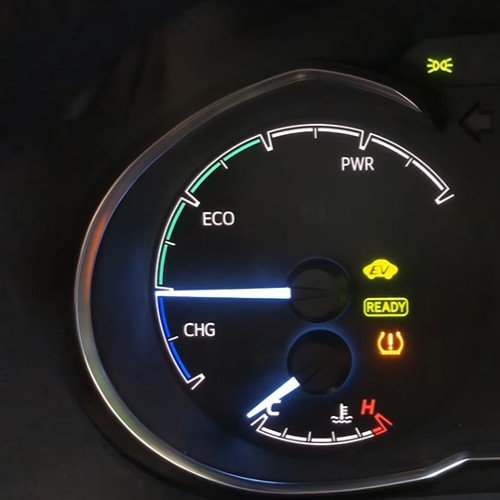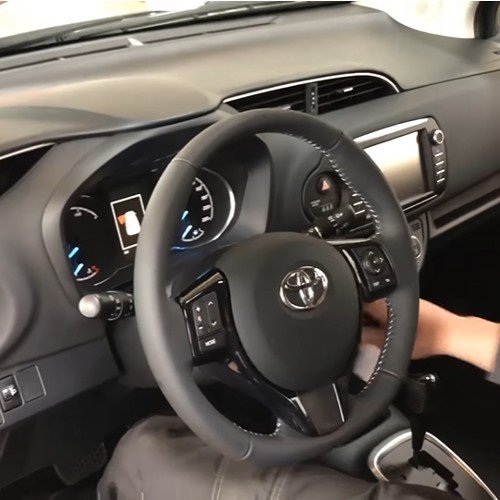
If you’ve ever been driving your Toyota Corolla and noticed an orange or yellow light on your dashboard, you may have wondered what it means. That orange light is your tire pressure monitoring system (TPMS) light, and it can be an important indicator of your tire health.
To diagnose and reset a blinking tire pressure light on a Toyota Corolla, check all of the tires to make sure they are inflated to the recommended pressure. If the tires are not inflated properly, fill them to the correct pressure.
If the tires are properly inflated, reset the tire pressure monitoring system by pressing and holding the tire pressure reset button for a few seconds. If the light continues to blink, the tire pressure monitoring system needs to be serviced or replaced.
In this article, we’ll discuss the causes of a blinking tire pressure light in a Toyota Corolla, and how to diagnose and reset it.
So let’s get started!
Causes of a blinking tire pressure light in a Toyota Corolla

The tire pressure light is an important indicator that can tell the driver when the tires need an inspection. Knowing the common causes of a blinking tire pressure light in a Toyota Corolla can help identify and resolve the issue quickly.
1. Low Tire Pressure
One of the most common causes of a blinking tire pressure light is low tire pressure. This can be caused by a leak in the tire, an underinflated tire, or a tire that has been punctured.
2. Sensor Malfunction
A possible culprit behind performance issues could be a TPMS sensor that isn’t working properly. It could be due to a malfunction, a damaged wiring harness, or a disruption in the connection between the sensor and the main control unit.
3. Low Battery Voltage
A blinking tire pressure light could be a warning sign of a low battery voltage, whether it’s due to a dead battery or a faulty alternator.
4. Notable Changes in Weather or Temperature
When temperatures plummet, the tire pressure light may start to blink, signaling that changes in the weather have caused a decrease in the pressure within the tire. This alert is meant to remind the driver to check the pressure.
How to Diagnose Blinking Tire Pressure light Toyota Corolla

If you’re behind the wheel of a Toyota Corolla and you notice the tire pressure light blinking, it’s a sign that something has gone awry. Here’s a rundown of how to diagnose the issue, step-by-step.
Step 1: Check Tire Pressure
The first step is to check the tire pressure in all four tires. Make sure that the tires are inflated to the recommended tire pressure as indicated in the owner’s manual or the sticker located on the driver’s side door jamb.
Step 2: Inspect the Tires
Inspect the tires for any signs of damage such as cuts, punctures, or bulges. If you find any damage, take your car to a tire shop to have them checked out and repaired.
Step 3: Check TPMS Sensors
Check the TPMS sensors for any signs of damage or corrosion. Make sure that the sensors are securely attached to the wheels and that the valve stems are intact.
Step 4: Scan the System
If the tire pressure is correct, the tires are in good condition, and the sensors are functioning properly, you will need to have the system scanned with a diagnostic tool. Take your car to a qualified mechanic or dealership and have them perform a diagnostic scan on the system.
Step 5: Repair the Issue
Once the diagnostic scan is complete, the mechanic will be able to identify the issue and make the necessary repairs to fix the blinking tire pressure light. This may include replacing a faulty sensor, repairing a damaged wire, or resetting the system.
How to Reset Blinking Tire Pressure light Toyota Corolla
Is your Toyota Corolla’s tire pressure warning light blinking? Don’t worry, we’ll show you how to reset it and get your vehicle running safely again with this simple, step-by-step guide.
Step 1: Start the car
Make sure the engine is running before you begin. This will ensure that you have the necessary power to reset the tire pressure system.
Step 2: Access the settings
Take a look at the interior of your vehicle and locate the function buttons on the right-hand side. Press the button labeled “right” twice to access the settings menu.
Step 3: Go to Vehicle Settings
Once you are in the settings menu, go to the bottom of the list and locate the “Vehicle Settings” option. Select this option by pressing the “OK” button.
Step 4: Access the TPWS
Find the “TPWS” option on the screen and press and hold the “OK” button to access it.
Step 5: Set the pressure
Once you are in the TPWS menu, use the “OK” button to set the correct tire pressure for your vehicle. You should see the “Tire Pressure Monitor System” start to flash.
Step 6: Wait for the system to reset
Keep holding the “OK” button until the flashing stops. This means that the system has been reset.
Step 7: Go back to the main menu
Press the “back” button twice to return to the main menu.
Step 8: Turn off the engine
Now that the tire pressure warning light has been reset, turn off the engine and wait a few moments.
Step 9: Restart the engine
Start the engine again to make sure that the warning light is no longer blinking.
Congratulations, you have successfully reset the tire pressure warning light on your Toyota Corolla!
Does altitude affect tire pressure?

At higher altitudes, the air pressure is lower than at lower altitudes, and this can affect the tire pressure in your car. As the elevation increases, the atmospheric pressure decreases and the air inside the tire expands. This causes the tire pressure to rise.
The reverse is true when the elevation decreases, the atmospheric pressure increases and the air inside the tire compresses, thus leading to a decrease in tire pressure. It is important to check your tire pressure regularly, especially when driving at higher elevations, as incorrect tire pressure can cause uneven tire wear and poor handling.
Final Verdict
By following the steps outlined in this article, you should now have the confidence to properly diagnose and reset your Toyota Corolla’s tire pressure light. Whether you are a beginner or an experienced driver, it’s important to stay informed about your vehicle’s maintenance and safety.
Taking the time to understand the workings of your Toyota Corolla can help you drive with peace of mind, knowing that you and your passengers are safe and secure.
FAQs
Is it safe to drive Corolla with low tire pressure?
No, it is not safe to drive a Corolla with low tire pressure. Low tire pressure can cause a variety of problems such as reduced traction, increased fuel consumption, and premature tire wear. It can also create an unbalanced ride, making it difficult to control the car, and can even lead to a blowout. Therefore, it is essential to check tire pressure regularly and maintain it at the manufacturer’s recommended level.
Is it better to inflate or adjust tire pressure in hot or cold weather?
It is always recommended to inflate tire pressure in cold weather. This is because cold temperatures cause air molecules to slow down and contract, which causes tire pressure to drop. If you inflate your tires when it’s cold outside, it ensures that they are properly filled and can help you get better traction and better fuel economy.
